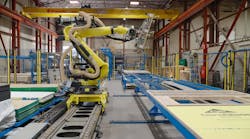An energy-management system (EMS) is used to control energy-consuming equipment, primarily that related to HVAC and lighting control. Ensuring that these systems operate properly can result in lower energy bills. By using basic HVAC fundamentals and mastering EMS design/operation, one can find energy waste stemming from defective control devices and poor EMS programming.
This article will describe how an EMS can support the search for energy waste from the facility-design stage through day-to-day operation.
FACILITY DESIGN
While the ideal time to incorporate energy-saving features into a facility is during design, well before building construction and operation, renovations also provide a great opportunity. Although the incremental cost of installing an energy-saving system most likely would be lowest during scheduled downtime or as a part of new construction, the project budget might not be able to support it. Estimating the potential internal rate of return (IRR) resulting from expected annual cost savings can help justify an increased budget. A business case detailing the scope, showing alternatives, and describing potential risks and rewards of the project can be prepared and a high IRR can help sell a project to management.
Replacement of HVAC equipment is an opportune time to incorporate more-efficient equipment and new EMS controls. Energy-saving strategies can change depending on the climate in which a facility is located. For a hot, humid climate, a few examples of energy-saving products include:
-
A heat pipe wrapped around the cooling coil in a 100-percent makeup-air unit, which can control humidity efficiently while minimizing cooling and reheat energy costs.
-
A variable-speed drive on a single-zone HVAC system, which can help control humidity and lower cooling and reheat costs.
-
Carbon-dioxide sensors on HVAC equipment, which can minimize outside air during low-occupancy periods.
EMS DESIGN
By taking an active role in the EMS-design process, an owner can gain a better understanding of HVAC- and lighting-controls design. This frequently gives the owner the opportunity to make energy-saving recommendations that can be incorporated into the EMS design.
However, there are some inherent problems with the traditional EMS-design process. First, an engineer's controls design seldom is more than a set of “typical” schematics accompanied by a narrative specification describing the desired results with little or no “how-to” instructions. The resulting EMS design is vague and performance-based. In the end, the owner gets a system that meets the original specifications, but might not be the same as — or even compatible with — the existing facility EMS. The owner operates this new system as just one of many disparate systems in his or her EMS portfolio.
An alternative EMS-design approach — one that results in a seamless integration of new facilities into a global EMS — is used by some owners. This process has two fundamental concepts. First, to ensure competitive bidding, EMS hardware is owner-furnished. Second, the EMS is designed as part of facility-design documents, which prescriptively specify all pertinent details. With this alternative approach, the installation of EMS wiring, conduits, sensors, and actuators — generally the most expensive part of an EMS — is competitively bid. A contractor with knowledge of the owner's preferred EMS manufacturers performs the EMS-panel final wire termination, programming, and startup. The owner's energy-management team coordinates the addition of the new panels to the central EMS server and prepares the EMS graphical interface. The owner knows exactly what he or she is getting and that the new equipment will integrate seamlessly into the existing EMS.
Making EMS design part of design documents helps an owner master an EMS, maximizing energy savings. This expertise begins with an intimate understanding of how an EMS works, including hardware and software, and develops with day-to-day operational experience and the adoption of EMS design standards.
BUILDING TUNE-UP
A building tune-up analyzes and optimizes a building's HVAC, lighting, and energy-management systems for improved performance and energy efficiency. Although difficult to predict for a single building, facility energy savings from a building tune-up typically range from 5 to 15 percent. The resulting actions generally are low-cost or no-cost adjustments to an existing EMS that not only minimize current operating costs, but lower future maintenance costs. A building tune-up does not necessarily involve the purchase and installation of new equipment or technology. Instead, it requires an investigative-style approach to ensure that EMS controls are working and managing HVAC and lighting systems optimally.
A building tune-up also includes a review of HVAC and lighting systems' time/set-point schedules, which are programmed into the EMS. During an initial EMS installation, it is not uncommon for an EMS contractor to set HVAC and lighting schedules to run continuously, leaving fine-tuning to the owner.
Meeting with facility representatives is the best way to determine optimal time schedules. A list of HVAC and lighting controls, as well as color-coded floor plans that highlight coverage areas, also is helpful. The resulting time/set-point schedules for a large campus facility should be kept in a database. To prevent inaccurate time/set-point adjustments, some EMSs automatically reset settings daily.
EMS AUDIT
An EMS audit is a detailed evaluation of an EMS's operation. Even the best EMS will experience control-equipment failures over time. Building owners should have a strategy to routinely check for such failures. Typical EMS failures include:
-
Indication of a chilled-water valve being “closed,” but display of a cold supply-air temperature, which suggests the valve is not closing.
-
Indication of a hot-water valve being “closed,” but display of a warm supply-air temperature, which suggests the valve is not closing.
-
Instruction that fans be off, but indication that fans are on.
-
Temperature- and humidity-sensor readings that appear to be out of range, which suggests a sensor defect.
-
The forcing of EMS points to manual, rather than automatic, control, which frequently suggests an operational or maintenance deficiency.
-
Display improper space or supply-air temperature settings, which suggests the set points differ significantly from typical settings.
-
Display occupancy-schedule settings that differ from similar spaces or units in the building.
-
Trimming/offsetting of space or supply-air temperature sensors that forces the HVAC system to supply additional heating/cooling when none is required.
-
Display duct static pressures significantly higher/lower than the air-handling unit's static-pressure set points, which suggests fan, belt, or airflow issues.
-
Display of very high or low space temperatures in spite of reasonable discharge-air temperatures, which often indicates deficient airflow or incorrect minimum settings.
-
Failure to communicate with equipment controllers.
-
Display of discrepancies between a damper's open/closed position and actual airflow.
Finding these kinds of problems can be simple: Search for discrepancies on a graphical display of the EMS's HVAC system. For example, the EMS display in Figure 1 shows a closed chilled-water valve and a supply-air sensor's low-temperature reading. Therefore, it is likely that the chilled-water valve is not closing properly. Obviously, this scenario includes a lot of energy waste, and immediate maintenance is necessary.
Once an EMS failure is identified, it is added to a summary spreadsheet. This spreadsheet makes issues easier to find, correct, and track. For each issue, a spreadsheet should contain:
-
A description of the issue and the action required to resolve it.
-
An identification number/point name for the effected equipment's controller and system.
-
A description of the effected system.
-
The issue's location, such as division, area, and/or building.
-
The date the issue was discovered.
-
The type of issue, such as problems with humidity, time/set-point schedules, pressure, variable-frequency drives, temperature, and chilled-/hot-water valves.
-
The issue's priority, such as high, medium, or low.
-
Any relevant values, such as temperature, humidity, pressure, fan status, etc.
A spreadsheet can be sorted by any of these criteria. This offers facility personnel a flexible tool that can help them maintain and repair equipment and controls. Also, it serves as a checklist that later can be reviewed to determine if appropriate repairs have been made or a system modification is needed.
An EMS audit should be followed by a field evaluation that investigates opportunities to reduce energy waste.
EMS ALARMS
An EMS can be programmed to send out an alarm when problems occur. If properly managed, these alarms can provide timely information to a maintenance department, allowing it to respond quickly. However, because their large volume can be overwhelming, critical alarms should be prioritized. High-priority alarms should be sent immediately via text message to lead maintenance personnel. For example, a high-temperature alarm for a chilled-water system would indicate a problem with a chiller, chilled-water pump, or cooling tower requiring immediate attention.
Another set of alarms can notify an owner of diagnostic issues. Because they can be large in number, these second-tier alarms can be used as the basis of a daily report summarizing all EMS failures requiring attention. The report can be sent via e-mail to the appropriate parties.
CONCLUSION
Energy savings starts during the design phase. A building tune-up can help fine-tune an EMS for optimal performance. With a thorough understanding of a facility's operating requirements, optimal HVAC- and lighting-system time/set-point schedules can be established. An EMS audit is more detailed, involving the study of the operation of HVAC and lighting systems for the identification and timely correction of problems. The results of these efforts are the proverbial “low-hanging fruit” on which energy managers should be focused.
ABOUT THE AUTHORS
Paul J. Allen, PE, is the chief energy-management engineer for Reedy Creek Energy Services (RCES), a division of Walt Disney World Co. He is responsible for the development and implementation of energy-conservation projects throughout the Walt Disney World Resort.
Michael J. Brennan, PE, CEM, LEED AP, is an energy-management engineer for RCES and responsible for conducting energy assessments to identify opportunities that reduce energy consumption within the Walt Disney World Resort.








